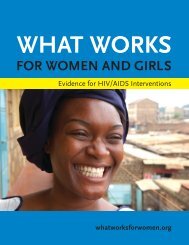Global Tuberculosis Report -- 2012.pdf
Global Tuberculosis Report -- 2012.pdf
Global Tuberculosis Report -- 2012.pdf
You also want an ePaper? Increase the reach of your titles
YUMPU automatically turns print PDFs into web optimized ePapers that Google loves.
of TB disease by 65%, irrespective of CD4 cell-count. 1IPT and ART given together can have an additive effectand substantially reduce the risk of developing active TBdisease among people living with HIV. This evidence isthe reason why updated WHO policy guidance on collaborativeTB/HIV activities (issued in 2012) includes earlierinitiation of ART along with the Three Is for HIV/TB askey interventions to prevent TB among people living withHIV. 2 ART is recommended for all TB patients living withHIV, irrespective of their CD4 cell-count.Testing TB patients for HIV and providing CPT to TBpatients living with HIV are typically the responsibilityof national TB control programmes (NTPs). National HIVprogrammes are usually responsible for initiating intensifiedcase-finding for TB among people living with HIV aswell as providing IPT to those without active TB. Provisionof ART to TB patients living with HIV has often beenthe responsibility of national HIV programmes, but canalso be done by NTPs, especially to facilitate better accessto care. When NTPs do not provide ART directly, they areresponsible for referring TB patients living with HIV toART services.WHO began monitoring the implementation andexpansion of collaborative TB/HIV activities in 2004.This chapter presents the latest status of progress, usingdata for 2004 up to 2011. 37.1 HIV testing for TB patientsIn 2011, the number of notified TB patients who had adocumented HIV test result reached 2.5 million (Figure7.1), equivalent to 40% of notified TB cases (Table 7.1, Figure7.2); this was an increase from 2.1 million and 33%respectively in 2010, and more than 10 times the level of3.1% reported in 2004 (Figure 7.2).The coverage of HIV testing for TB patients was particularlyhigh in the African Region, where 69% of TBpatients had a documented HIV test result in 2011, upfrom 60% in 2010. Impressively, in 28/46 African countries,75% of TB patients had a documented HIV testresult in 2011 (Figure 7.3), up from 22 countries in 2010.In Kenya, Rwanda, Mozambique, Swaziland, Togo, theUnited Republic of Tanzania, Zambia and Zimbabwe,1Suthar AB et al. Antiretroviral Therapy for Prevention of<strong>Tuberculosis</strong> in Adults with HIV: A Systematic Reviewand Meta-Analysis. PLoS Medicine, 2012, 9(7): e1001270.(doi:10.1371/journal.pmed.1001270).2WHO policy on collaborative TB/HIV activities: guidelines for nationalprogrammes and other stakeholders. Geneva, 2012 (WHO/HTM/TB/2012.1).3This chapter does not discuss infection control or servicesaimed at preventing HIV among TB patients. Data for infectioncontrol are limited for most countries, but available datacan be accessed at www.who.int/tb/data. Data on HIV preventionservices for TB patients are collected by WHO’s HIVdepartment and UNAIDS as part of their joint monitoring ofprogress towards universal access and the global response toAIDS.FIGURE 7.1TB patients (thousands)25002000150010005000FIGURE 7.2Percentage of TB patients706050403020100Number of TB patients with knownHIV status, 2004–2011HIV statusPositiveNegative2004 2005 2006 2007 2008 2009 2010 2011Percentage of TB patients with knownHIV status, 2004–2011African region<strong>Global</strong>Regions outside Africa2004 2005 2006 2007 2008 2009 2010 2011>85% of TB patients had a documented HIV result (Table7.1). <strong>Global</strong>ly, there were 80 countries in which 75% ofTB patients had a documented HIV test result.Outside the African Region, in 2011 the percentageof TB patients who had a documented HIV test resultexceeded 50% in the European Region and the Regionof the Americas (mostly influenced by the numbers of TBpatients with a documented HIV test result in the RussianFederation and Brazil, respectively). In other regions, thepercentage ranged from 11% in the Eastern MediterraneanRegion to 32% in the South-East Asia Region. Inthe 41 high TB/HIV burden countries identified as prioritiesfor TB/HIV at the global level in 2002 (listed in Table7.1), overall 45% of TB patients notified in 2011 had adocumented HIV test result; levels of HIV testing wereespecially low in Indonesia and Myanmar (Table 7.1).The highest rates of HIV coinfection were reported forTB patients in the African Region (Table 7.1), where 46%of those with an HIV test result were HIV-positive (comparedwith 44% in 2010). The percentage of TB patientsfound to be HIV-positive in the 28 African countries inthe list of 41 priority countries ranged from 8% in Ethiopiato 77% in Swaziland. Besides Swaziland, 50% ofthe TB patients with an HIV test result were HIV-positivein Botswana, Lesotho, Malawi, Mozambique, Namibia,South Africa, Uganda, Zambia and Zimbabwe.GLOBAL TUBERCULOSIS REPORT 2012 75
















